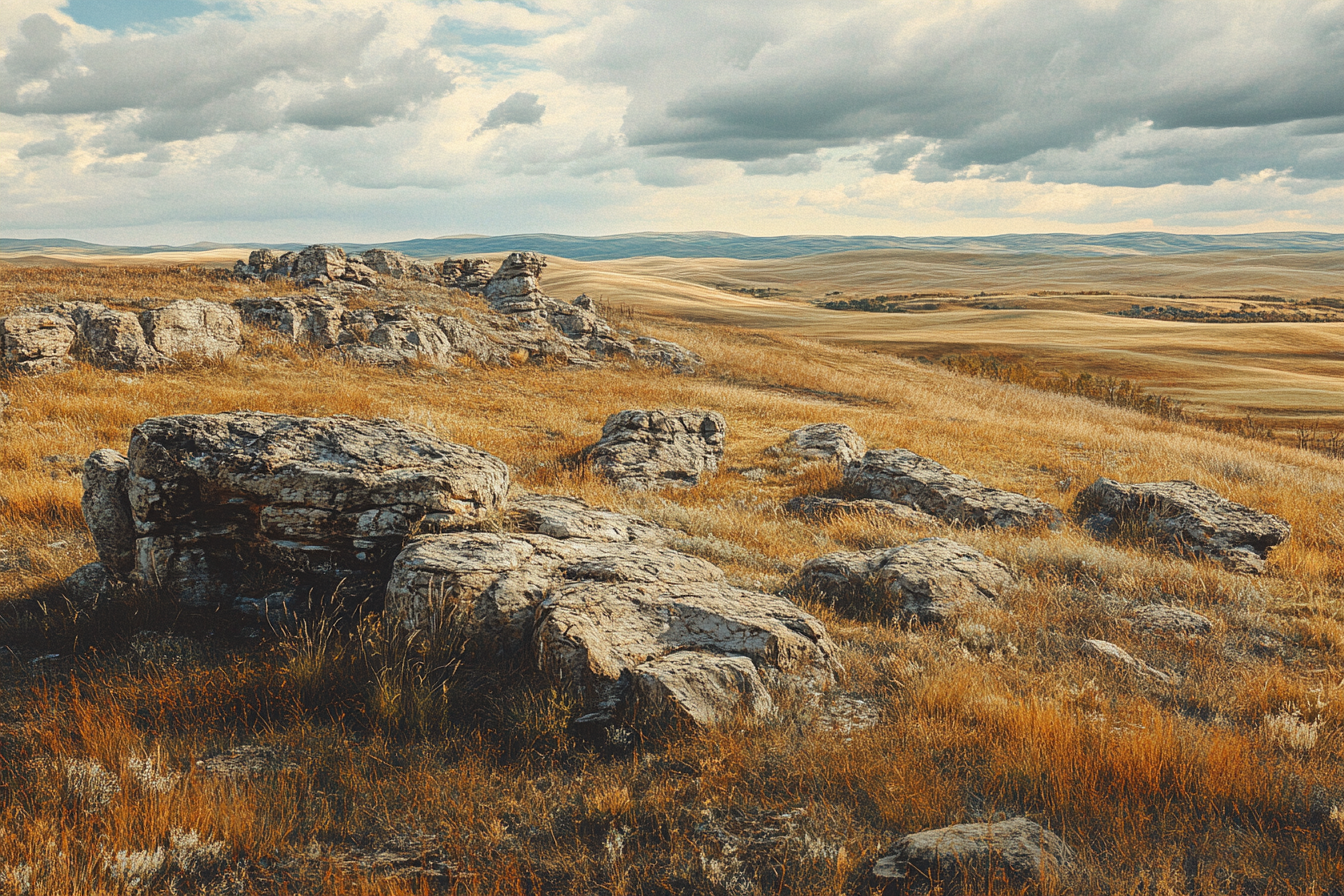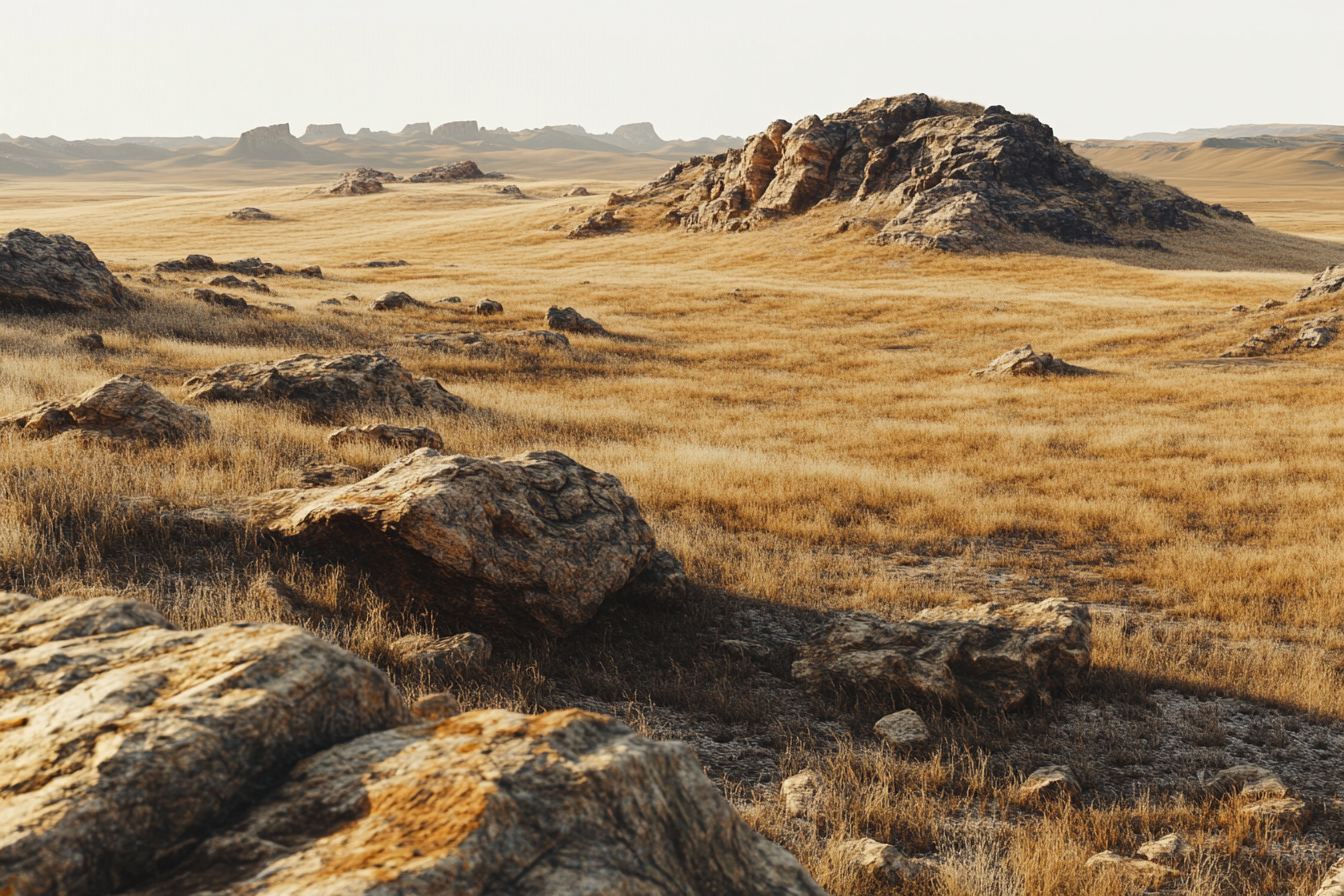Jorrandir
Pronunciation: jor-RAN-dear
Map Index: G4
Location: South central Beorlan, between Vornlithdor and the Bhoras Desert
Geography: Once a part of Palanlad, today Jorrandir remains separated from the other areas of great plains by the ash-filled wasteland of Vornlithdor. Covered by short grasses, these rolling lands became increasingly arid following the Great Cataclysm. Areas of rock and small low buttes are scattered across the rolling plains, while long narrow linear swaths of dead grasses mark the recent passage of Chaos Storms.
Primary Population: Turoch
Secondary Population: Fire Goblin
Minor Population: Stryx
Climate: With a semi-arid and tropical climate, rainfall in Jorrandir occurs mainly during the winter months, when it greens up the landscape, and leads to the fresh growth of grasses and the appearance of flowers. By late spring, drought begins to cause the rolling plains to brown as plants ready themselves by going dormant in order to survive the long days of summer with great heat and little rain. By mid autumn the temperatures begin to cool a bit, heralding the return of long-awaited rainfall.
Wildlife: Great herds of antelopes, gazelles, and wild horses graze near watering holes during the heat of day. Leopards stalk their prey near rocky outcrops and the long grass areas near streams and watering holes.
Humanoids: The Turoch claim all of Jorrandir as their ancestral home but do not have any permanent habitations inside its borders due to dangerous outbreaks of Chaos Storms. However, they have hidden underground emergency shelters scattered across the landscape that they use to safely ride out the storms.
The fire goblins of Gok Grusmak frequently journey into the northern part of Jorrandir to hunt game. They ride great black worgs and hunt in large numbers. Fearing Chaos Storms, they make short forays and quickly return home as soon as they fill their mounts with meat.
In the eastern lands near the Bhoras Desert there are small colonies of the insect-like Stryx. They live in shallow burrows that they dig into the soil. As is their habit, they remain in their burrows during daylight hours and emerge each evening in search of food. Well-concealed burrow entrances make detecting their presence very difficult.
Monsters: These scenic plains contain many hidden threats. Bulettes, with their great armored hides and powerful jaws, present the greatest menace on the ground. Other dangerous creatures common to Jorrandir include dire hyena, jaculi, and ankheg. From the air, death awaits those unlucky enough to cross paths with a Roc, a gargantuan raptor large enough to carry away an antelope, a horse or a person.
History: Prior to the Great Cataclysm, this land was controlled by the Turochian Khanate. These nomadic tribes, forsaking the civilized culture of the Kishari Empire, lived free upon the plains of the southern part of Palanlad. When the Great Cataclysm struck, the surviving people of this area became corrupted by the Chaos Storms, creating the Turoch race.
Today: Jorrandir presents many challenges for those who cross its borders. Occasional Chaos Storms still come in from the south and southwest bringing death and corruption with them. They can strike suddenly due to their fast speed of movement which often exceeds 50 to 60 miles per hour.
Map Index: G4
Location: South central Beorlan, between Vornlithdor and the Bhoras Desert
Geography: Once a part of Palanlad, today Jorrandir remains separated from the other areas of great plains by the ash-filled wasteland of Vornlithdor. Covered by short grasses, these rolling lands became increasingly arid following the Great Cataclysm. Areas of rock and small low buttes are scattered across the rolling plains, while long narrow linear swaths of dead grasses mark the recent passage of Chaos Storms.
Primary Population: Turoch
Secondary Population: Fire Goblin
Minor Population: Stryx
Climate: With a semi-arid and tropical climate, rainfall in Jorrandir occurs mainly during the winter months, when it greens up the landscape, and leads to the fresh growth of grasses and the appearance of flowers. By late spring, drought begins to cause the rolling plains to brown as plants ready themselves by going dormant in order to survive the long days of summer with great heat and little rain. By mid autumn the temperatures begin to cool a bit, heralding the return of long-awaited rainfall.
Wildlife: Great herds of antelopes, gazelles, and wild horses graze near watering holes during the heat of day. Leopards stalk their prey near rocky outcrops and the long grass areas near streams and watering holes.
Humanoids: The Turoch claim all of Jorrandir as their ancestral home but do not have any permanent habitations inside its borders due to dangerous outbreaks of Chaos Storms. However, they have hidden underground emergency shelters scattered across the landscape that they use to safely ride out the storms.
The fire goblins of Gok Grusmak frequently journey into the northern part of Jorrandir to hunt game. They ride great black worgs and hunt in large numbers. Fearing Chaos Storms, they make short forays and quickly return home as soon as they fill their mounts with meat.
In the eastern lands near the Bhoras Desert there are small colonies of the insect-like Stryx. They live in shallow burrows that they dig into the soil. As is their habit, they remain in their burrows during daylight hours and emerge each evening in search of food. Well-concealed burrow entrances make detecting their presence very difficult.
Monsters: These scenic plains contain many hidden threats. Bulettes, with their great armored hides and powerful jaws, present the greatest menace on the ground. Other dangerous creatures common to Jorrandir include dire hyena, jaculi, and ankheg. From the air, death awaits those unlucky enough to cross paths with a Roc, a gargantuan raptor large enough to carry away an antelope, a horse or a person.
History: Prior to the Great Cataclysm, this land was controlled by the Turochian Khanate. These nomadic tribes, forsaking the civilized culture of the Kishari Empire, lived free upon the plains of the southern part of Palanlad. When the Great Cataclysm struck, the surviving people of this area became corrupted by the Chaos Storms, creating the Turoch race.
Today: Jorrandir presents many challenges for those who cross its borders. Occasional Chaos Storms still come in from the south and southwest bringing death and corruption with them. They can strike suddenly due to their fast speed of movement which often exceeds 50 to 60 miles per hour.

